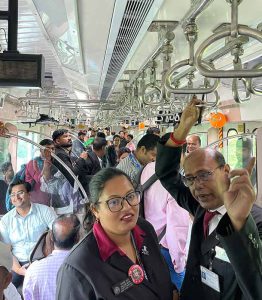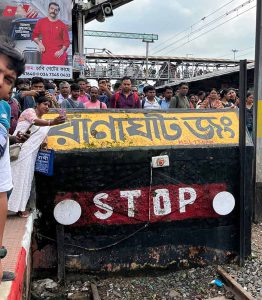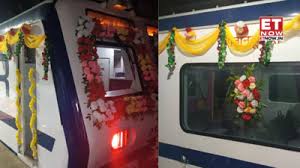Synopsis:
AC Local makes its first run between Ranaghat and Sealdah, drawing curiosity, comfort-seekers, and sceptics. From first-time riders to daily commuters, the train sparks both excitement and debate over its fare and necessity.
By Dr. Mohammad Farooque | Qalam Times News Network
Ranaghat | August 12, 2025
First Day, First Ride

The AC Local service on the Ranaghat–Sealdah route made its maiden journey on Monday morning, promising a more comfortable option for suburban commuters. Departing Ranaghat at 8:29 am, the inaugural run drew a diverse crowd—from enthusiastic first-time passengers to those boarding out of sheer necessity.
I arrived at Ranaghat well before sunrise, tasked with covering the event as both a journalist and a passenger. At the ticket counter, the process of buying the first-ever AC Local ticket turned into a small episode of confusion. The middle-aged clerk, surprised by the request, took nearly seven minutes—after checking with colleagues and adjusting the system—to hand over the ticket for ₹120. For regular commuters, the monthly pass is priced at ₹2,200.
Comfort for Some, Curiosity for Others

Not everyone at the station was impressed. Four young men hanging from the doorway of a non-AC local dismissed the idea outright, saying they preferred the open doors to a closed, climate-controlled coach. Yet for people like Subodh Dey, the AC Local was no luxury but a necessity. Accompanying his wife, who is undergoing chemotherapy, he said, “Earlier, travelling in the crowd caused her discomfort. This train will make the journey easier.”
Others boarded simply for the novelty. Debashis Chattopadhyay, a regular commuter from Ranaghat to Barasat, called it a “joyride” he couldn’t afford daily. Dr. Prabir Kumar Biswas, a paediatrician, decided the AC Local would now be his weekly choice for travelling to his chamber in Chakdaha to avoid the rush.
A Journey Worth the Detour

Some passengers went out of their way just to experience the inaugural ride. Tapan Kumar Roy from Singur took three changes of transport before reaching Ranaghat, only to travel as far as Dum Dum and return. Onboard, a group of young vloggers recorded every detail, one travelling from as far as Raiganj to document the moment.
By 8:10 am, the train was announced on Platform 5, drawing camera phones and selfies from onlookers. Even the ticket examiners—three women and seven men—joined in taking photos. Security was tight, with multiple RPF personnel stationed along the platform and onboard.
Different Stories in Different Seats
Among the passengers was Manoj Mondal, travelling with his wife and three-month-old child to board a long-distance train from Shalimar. “With the crowd in regular locals, this would have been impossible,” he said, happy to pay extra for comfort. In another corner, TCS employee Richa Sen sat with her husband, declaring she would switch to the AC Local for her Salt Lake commute.
The train maintained a steady flow of passengers but never reached full capacity. A few were fined for travelling with regular tickets instead of AC Local tickets—like Roshan Singh, who paid ₹280 on the spot. Government employees in one compartment admitted the service was too expensive for daily use and unsuitable for their office timings.
The Ride and the Reception
Covering 11 stations—Ranaghat, Chakdaha, Kalyani, Kanchrapara, Naihati, Barrackpore, Khardah, Sodepur, Dum Dum, Bidhannagar, and Sealdah—the journey took 103 minutes. The cool interiors, calm atmosphere, and absence of door-side crowds stood in stark contrast to the adjoining non-AC local crammed with commuters.
At 10:12 am, the AC Local pulled into Sealdah almost parallel with the Rajdhani Express, marking the end of its first run. The TTEs said staffing levels for daily operations were yet to be finalised. For some, this train could be a daily comfort; for others, just an occasional indulgence. But for everyone on that first day, it was a ride worth remembering.







